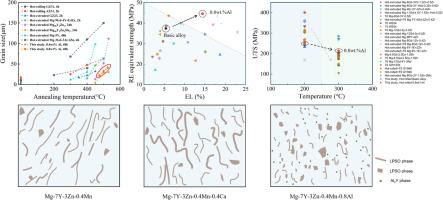添加Al/Ca元素提高Mg-7Y-3Zn-0.4Mn合金的耐热性和热稳定性
IF 13.8
1区 材料科学
Q1 METALLURGY & METALLURGICAL ENGINEERING
引用次数: 0
摘要
温度升高导致镁基合金的强度降低。在高温下(200-300°C),即使是稀土增强镁合金也会出现明显的强度下降。本文通过在Mg-7Y-3Zn-0.4Mn合金中添加不同成分(0.4 wt.%和0.8 wt.%)的Ca或Al来提高使用温度。Al元素有效地提高了Mg-7Y-3Zn-0.4Mn的强度,Al添加量越大,强度越高,特别是在300℃时。当Al含量为0.8 wt.%时,Mg-7Y-3Zn-0.4Mn合金的抗拉强度由181 MPa提高到213 MPa,而在200 ~ 300℃时,合金的抗拉强度仅下降36 MPa(由249 MPa降至213 MPa)。在室温下和高温下(300℃),Al合金化均能有效提高Mg-7Y-3Zn-0.4Mn合金的EL,分别从5.4%提高到14.4%和8.2%提高到23.1%。铝元素显著提高了材料的热稳定性,且在较高温度下效果更为显著。在475℃下长时间退火48 h后,Mg-7Y-3Zn-0.4Mn-0.8Al合金的晶粒尺寸从16.9增加到23µm,增幅有限。在525℃下退火48 h后,Mg-7Y-3Zn-0.4Mn-0.8Al合金的晶粒尺寸仍保持在41µm左右。而在碱性合金和0.4 wt.% Ca合金中,晶粒长大超过150µm。在微观结构方面,Ca的加入主要促进了LPSO相的形成和随后的粗化。Al合金化导致三种明显的微观结构变化:LPSO相从互连网络转变为离散块状,Al2Y颗粒均匀析出,第二相分布更加均匀。Al元素对织构也有削弱作用。研究了Ca/Al对Mg-7Y-3Zn-0.4Mn合金力学性能、热稳定性和显微组织影响的基本机理。本文章由计算机程序翻译,如有差异,请以英文原文为准。

Improvement heat resistance and thermal stability of Mg-7Y-3Zn-0.4Mn alloy by Al/Ca element addition
Elevated temperatures lead to a reduction in the strength of magnesium-based alloys. At elevated temperatures (200–300 °C), even rare-earth reinforced Mg alloys experience notable strength deterioration. In this paper, the additions of different composition (0.4 and 0.8 wt.%) of Ca or Al in Mg-7Y-3Zn-0.4Mn alloy is added to increase the service temperature. The strength of Mg-7Y-3Zn-0.4Mn is effectively improved by Al element and higher after more Al is added, particularly at 300 °C. Specifically, the ultimate tensile strength (UTS) of Mg-7Y-3Zn-0.4Mn alloy increases from 181 MPa to 213 MPa by adding 0.8 wt.% Al. Remarkably, the UTS declines merely by 36 MPa (from 249 to 213 MPa) between 200 °C and 300 °C. And at both RT and elevated temperature (300 °C), Al alloying effectively improves the EL of Mg-7Y-3Zn-0.4Mn alloy, with improvements from 5.4 % to 14.4 % and 8.2 % to 23.1 %, respectively. Al element has dramatically increased the thermal stability and more significant effect at higher temperature. After prolonged annealing at 475 °C for 48 h, the Mg-7Y-3Zn-0.4Mn-0.8Al alloy shows only a limited increase in grain size from 16.9 to 23 µm. Even after annealing at 525 °C for 48 h, the Mg-7Y-3Zn-0.4Mn-0.8Al alloy maintains a grain size of approximately 41 µm. However, the growth of grain in basic alloy and 0.4 wt.% Ca alloy exceeds 150 µm. For microstructure, Ca addition primarily promotes LPSO phase formation and subsequent coarsening. Alloying with Al leads to three distinct microstructural changes: the LPSO phase transitions from interconnected networks to discrete blocks, Al2Y particles precipitate homogenously, and second phases distribute more uniformly. And the texture is also weakened by Al element. Essential mechanisms of Ca/Al effects on mechanical properties, thermal stability, and microstructure in Mg-7Y-3Zn-0.4Mn alloys are investigated.
求助全文
通过发布文献求助,成功后即可免费获取论文全文。
去求助
来源期刊

Journal of Magnesium and Alloys
Engineering-Mechanics of Materials
CiteScore
20.20
自引率
14.80%
发文量
52
审稿时长
59 days
期刊介绍:
The Journal of Magnesium and Alloys serves as a global platform for both theoretical and experimental studies in magnesium science and engineering. It welcomes submissions investigating various scientific and engineering factors impacting the metallurgy, processing, microstructure, properties, and applications of magnesium and alloys. The journal covers all aspects of magnesium and alloy research, including raw materials, alloy casting, extrusion and deformation, corrosion and surface treatment, joining and machining, simulation and modeling, microstructure evolution and mechanical properties, new alloy development, magnesium-based composites, bio-materials and energy materials, applications, and recycling.
 求助内容:
求助内容: 应助结果提醒方式:
应助结果提醒方式:


